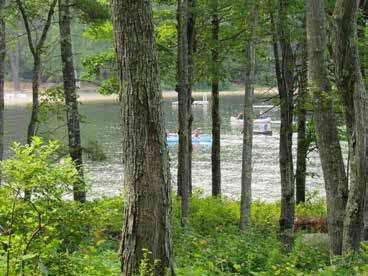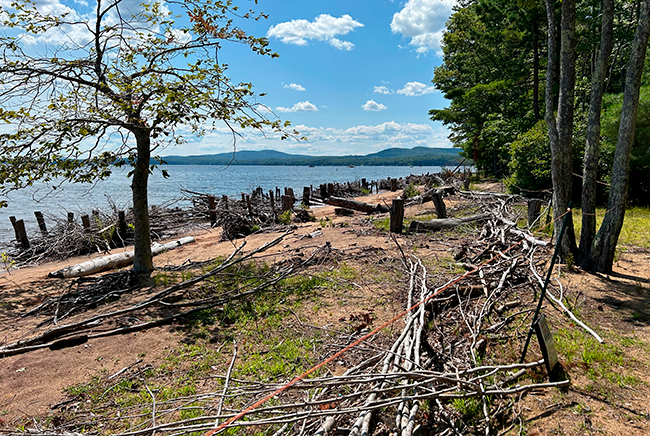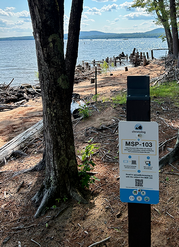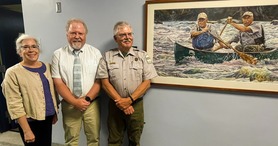 September 2024
Deboullie Public Lands, Maine Bureau of Parks and Lands.
Once upon a time, forest management in Maine was mostly about timber production. On Maine's Public Lands, we're still strongly engaged in growing and harvesting trees to support local economies and generate revenue that funds our stewardship needs. (Public Lands are almost entirely funded through timber revenues). That being said, forest management in 2024 involves so much more than delivering wood to local mills. Habitat values, carbon storage, insect and disease resistance, outdoor recreation, water quality, aesthetics, and other public values are integrally woven into nearly all conversations about forestry these days.
Dr. John Hagan joined MNAP staffers Molly Docherty and Kristin Puryear and others at Deboullie to look at old forest stands.
In the last month I was lucky to visit some of my favorite Public Lands in Aroostook County to talk forests and forestry -- not once, but twice! In late July, I joined John Hagan and Ben Shamgochian of Our Climate Common, along with BPL foresters and Maine Natural Areas Program ecologists, to better understand Our Climate Common’s project using LiDAR to map Late Successional and Old Growth ('LSOG') forests. These older forest stands are uncommon in Maine's working forest and support valuable habitat and carbon storage.
Dr. Mac Hunter and Dr. Laura Kenefic discussed softwood management at Eagle Lake Public Lands.
A few weeks later, I joined BPL's Silvicultural Advisory Committee to discuss some emerging forestry challenges, including spruce and cedar regeneration in the face of a changing climate. Led by BPL Deputy Director Bill Patterson and Chief Forester Mike Pounch, BPL takes the concept of ‘Public’ lands seriously, and our experienced team of foresters, ecologists, wildlife biologists, and recreation planners is passionate about safeguarding the future of these woods for years, decades, and centuries to come.
~ Andy Cutko, Director, Maine Bureau of Parks and Lands
Top of page
The State Park Campground Reservations Call Center will close for the season on Friday, September 6, 2024, at 4:00 p.m. EST. Thank you for a wonderful camping season. We hope to see you again next summer!
-
Internet Reservations will continue through to Saturday, 9/7/2024 until 4:00 p.m. EST at www.CampWithME.com
Off Season & Winter Camping
*Camping season ends for the year for:
-
Cobscook Bay State Park: Park closes on Sept. 16, 2024 for park improvements and will remain closed until further notice.
-
Peaks-Kenny: Campground closes for the year on October 1
-
Rangeley Lake: Campground closes for the year on October 1
-
Warren Island: Campground closes for the year on September 15
-
Campground rates vary by location.
-
Campground Maps.
- No camping is permitted at the Parks from October 16 to December 14. This break allows for park maintenance of the campground areas.
-
Winter Camping, as primitive tent camping only, is offered December 15 - March 15 at select Maine State Park Campgrounds.
For Call Center & Online Reservations:
- Lily Bay State Park AND Sebago Lake State Park – Monday, February 3, 2025, at 9:00 AM, EST (storm date if Maine State Government is closed – Tuesday, February 4, 2025)
- All parks - Thursday, February 6, 2025, at 9:00 AM, EST (storm date if Maine State Government is closed – Friday, February 7, 2025)
www.CampWithME.com
For Group Campsite and Group Picnic Shelter Reservations – for all parks
- Monday, February 3, 2025, at 9:00 AM, EST (storm date if Maine State Government is closed – Tuesday, February 4, 2025)
Call the park-specific phone numbers for these reservations:
~ Madelyn Johnson, Campground Reservations Center Manager
Top of page
The Bureau of Parks and Lands is happy to announce that major improvements are underway at the Cobscook Bay State Park campground. Construction that doesn’t affect the use of the park has already begun.
In the interest of safety, and to ensure that the projects are complete before the 2025 camping season, the Bureau of Parks and Lands is closing the park on Monday, September 16, 2024. Please consider camping at one of our other State Parks for the rest of the season.
We greatly appreciate your understanding and look forward to hosting your camping trip next season with improved facilities!
For more information contact me at 207-941-4014.
~ Matthew Hamilton, Northern Regional Park Manager
Top of page
Bradbury Mt. State Park, Pownal
Camden Hills State Park, Camden
Colonial Pemaquid State Historic Site
Holbrook Island Sanctuary, Brooksville
Reid State Park, Georgetown
Wolfe's Neck Woods State Park
Top of page
Maine State Parks welcomes Girl Scouts of Maine on this special weekend of nationwide celebration because Girl Scouts Love State Parks! We thank you for your appreciation of and service to Maine State Parks. Girls Scouts, and their family members that accompany them in their car, will receive FREE day entry in exchange for sharing their park experience. Entry to the parks is only for day use and has the same location exceptions as a park pass. Be sure to wear your Girl Scout vest or sash so that you will be recognized as a Girl Scout during your visit.
Girl Scouts visiting Fort Knox on a past Girl Scouts Love State Parks Weekend.
Join us for an incredible day of outdoor activities, live animal presentations by Chewonki, a special visit by Smokey Bear with a cake cutting at 11:30 a.m. in honor of his 80th birthday, Maine Master Naturalists will have a table and lead hikes, and so much more! Over a dozen outdoor organizations are participating to make this an incredible event. View the flyer with the schedule of events.
Top of page
Restoring the shoreline at Sebago Lake State Park.

Article by Carina Brown
Water Resources Specialist, Portland Water District
Sebago Lake State Park has experienced some of the most severe erosion on the lake. Intense wind, waves, and high water levels have toppled trees and pulled shoreline and beach sand away. Over 100 linear feet of shoreline has been lost since the 1970s in some areas. When shoreline washes into the lake, so does phosphorus, a nutrient that can cause algae blooms. As stewards of Sebago Lake, the Sebago Lake State Park (SLSP) and Portland Water District (PWD) recently partnered on a project at SLSP’s popular Songo Beach swimming area. The project aims to address the erosion while serving as a demonstration site for living shoreline stabilization on a Maine lake.
What are living shoreline techniques?
Historically retaining walls were the first solution to shoreline stabilization, followed by riprap (angular stone). Both act as barriers between the land and lake and can deflect wave energy to neighboring sites.
We selected to use a living shoreline technique because living shorelines mimic undisturbed/undeveloped shorelines by using plants and other natural materials to stabilize the shore and provide a transition zone between the land and lake. Natural materials included in living shorelines can create a shoreline that gets stronger over time instead of needing routine maintenance. These methods are more cost effective for shorefront property owners and beneficial to water quality and wildlife. Using living shoreline stabilization techniques on a Maine lake makes this project a first-of-its-kind endeavor. Now several living shoreline stabilization techniques are viewable, in action, at SLSP’s Songo Beach. The structures are primarily built from trees harvested from SLSP inland forests. All parts of the tree have a part to play. You can see tree roots pointed at the lake, logs posted upright, and branches and brush woven among the logs. Other living shoreline structures on display use beach sand wrapped in coconut-fiber fabric and new plantings of native perennials.
|
 |
-
ROOTWADS - The rootwads absorb energy of some of the largest waves.
-
FABRIC-WRAPPED SOIL LIFTS - The biodegradable fabric-wrapped soil lifts provide a stable upper shoreline into which the plantings can become established to create even more stability.
-
BRANCHES AND BRUSH - The branches and brush woven around the upright logs absorb energy from less intense waves and trap sand and sediment carried in waves.
-
NATIVE PERENNIALS - Once planted, native perennials like these will stabilize the upper shoreline and the soil lift fabric will decompose.
In addition to stabilizing the shore and trapping sand and sediment, another goal exists to these structures, which includes creating a better balance between keeping sediment on shore and losing sediment from the shore. This will happen over time as the beach elevation rises and the slope into the lake becomes gentler, resulting in lower energy waves.

When all of these goals succeed, the beach appearance will change. As sediment builds up in some of the structures they’ll get buried and naturalized as vegetation grows, stabilizing the shore even more once those roots get established. The way it looks now is a temporary look for a long-term solution to beach erosion.
A final goal is that this effort will serve as a pilot project. We want it to succeed so others with eroding shorelines will follow suit and choose living shoreline stabilization techniques instead of, or in addition to, traditional riprap. In partnership, SLSP and PWD will monitor the function of these structures and verify their success. We’re hopeful the positive impact will be clearly visible to all visitors of the Sebago Lake State Park. Please visit the Songo Beach and see for yourself and
visit Sebago Lake State Park’s Shoreline Restoration Project webpage for photos of the construction, engineering designs, and updates.
Funding for this project, in part, is provided by the U.S. Environmental Protection Agency under Section 319 of the Clean Water Act. The funding is administered by the Maine DEP in partnership with EPA.
|
 |
Shorline restoration near the Chronolog picture post MSP-101. You can help us recod the shoreline change by using the three Chronolog picture posts at the Songo Beach near the playground. Picture post MSP-103 is shown below.

Next time you visit Sebago Lake State Park get out your smartphone for some fun taking pictures that will help us record the shoreline changes along the lake.
Three Chronolog picture posts have been installed on Songo Beach. You'll find picture post MSP-101 near the shoreline behind the playground at the north end of the beach. Follow the shoreline pathway north (to your right when facing the lake) to find picture post MSP-102 and MSP-103. Taking the photos is simple, fun, and easy to do. You'll find a convenient slot on the post to hold your phone in landscape orientation for you, and uploading your photo is made easy by the listed short URL or the QR code. Your photos will be saved and Chronolog will send you an email with a link to view the slideshow of the beach over time.
Your photos will help us monitor the results of the shoreline restoration project (see article above) over the next several years. Below are links to the current slideshow at each of the three shoreline restoration locations.
Thank you in advance for getting involved in this project.
~ Paul Baker, Manager, Sebago Lake State Park
Top of page
|
 |
Above: Artist Michael Vermette with donated watercolor "Allagash Rangers Shooting Chase Rapids." Below: Adrienne Paiewonsky, Michael Vermette, and Bob Johnston the AWW Ranger who is pictured in the bow of the canoe in the watercolor.

We deeply thank patron Adrienne Paiewonsky and artist Michael Vermette for their remarkable contributions to the DACF and Allagash Wilderness Waterway. As Adrienne beautifully expressed, what sets the Allagash Wilderness Waterway (AWW) Rangers apart are their knowledge, skill, experience, and cooperation. These qualities were essential in helping Michael Vermette, our inaugural AWW Visiting Artist in 2020, maximize every moment of his time in the Allagash.
Michael's artistic talent, combined with his expertise and curiosity, resulted in stunning artwork and what can be called an incredible adventure story, painting the beauty and spirit of the Allagash. This week, Michael and his wife, Elaine, Adrienne, and her husband, Paul Girdziz, presented the breathtaking watercolor "Allagash Rangers Shooting Chase Rapids" as a gift to commemorate the program and memorialize the waterway experience. The painting now hangs proudly in a prominent location at the Department of Agriculture, Conservation and Forestry (DACF) HQ, where all staff and visitors can admire its beauty.
Visit Michael Vermette's website to learn more about him and his work, including his book 50 PLUS ONE, which features "Allagash Rangers Shooting Chase Rapids" on its cover.
Thank you, Adrienne, Paul, Michael, and Elaine, for your kindness and generosity and for beautifully capturing the essence of the Allagash Wilderness Waterway.
~ Mark Deroche, Superintendent of the Allagash Wilderness Waterway
Top of page
|
Send article suggestions or newsletter comments to Jocelyn Hubbell, Interpretive Specialist, webmaster, and newsletter editor for the Maine Bureau of Parks and Lands.
Read back issues of the newsletter.
|
